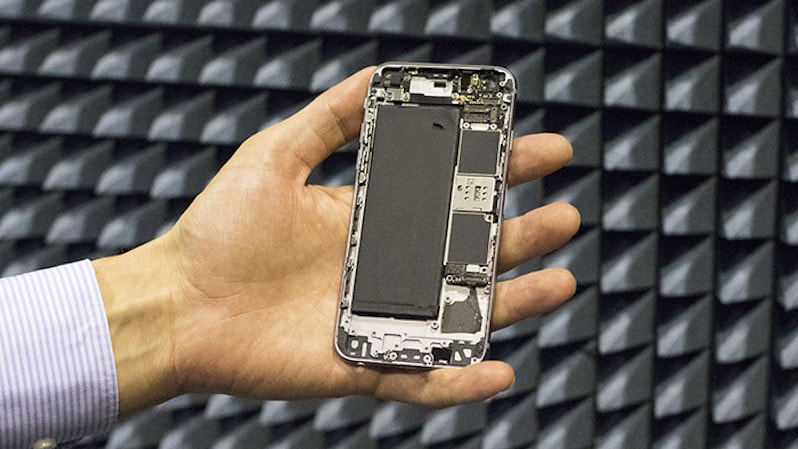- Home
- Mobiles
- Mobiles News
- New Digital Antenna Could Revolutionise Mobile Phones: Study
New Digital Antenna Could Revolutionise Mobile Phones: Study

Scientists have developed new digital antennas which may lead to next generation of smartphones that are more energy efficient and are up to 100 to 1000 times faster than current cellphones.
Currently, smartphone antennas are placed at the top and bottom of the screens, which means phone's touch screen does not cover the entire phone. With the help of new method, developed by researchers at Aalto University in Finland, antennas need less space and the phone display can be made larger and the phone design can be more free.
The new antenna makes it possible to reach the data transfer speed set as the objective for the next generation of phones, which is 100 to 1000 times faster than that of current phones.
In addition, battery life will be improved owing to the greater efficiency of the new method. With the new digital antennas, "many smartphone
applications like GPS, Bluetooth and Wi-Fi will no longer need their own antennas," said Jari-Matti Hannula, a doctoral candidate at Aalto University.
"All of the phone's data transfer can take place through one digitally controlled antenna. This in turn makes phone design easier and enables a larger screen size as the antenna does not require so much space," added Hannula. Traditionally one antenna works with either one or a few different frequencies. With the new digital antennas, several small antenna elements can be combined to work together as one antenna that can be made to operate digitally with any frequency, researchers said.
These new antennas may also dispose of the analogue components that traditional antennas use to tune into the desired frequency. This facilitates antenna design and enables the creation of more compact antennas with better radiation efficiency.
Antenna's radiation efficiency has in recent times been falling because the frequency range used by mobile phones has been continuously increasing. Poor radiation efficiency leads to a short transmission range, for which network operators are then forced to compensate with a denser network of base stations.
Energy is wasted in both the phone and the base station. In addition, increasing the network density is expensive. The new method will revolutionise the fifth generation of mobile phones. The antennas currently in use are mostly based on technology developed half a century ago. The research was published in the journal IEEE Antennas and Wireless Propagation Letters.
Get your daily dose of tech news, reviews, and insights, in under 80 characters on Gadgets 360 Turbo. Connect with fellow tech lovers on our Forum. Follow us on X, Facebook, WhatsApp, Threads and Google News for instant updates. Catch all the action on our YouTube channel.
Related Stories
- Samsung Galaxy Unpacked 2025
- ChatGPT
- Redmi Note 14 Pro+
- iPhone 16
- Apple Vision Pro
- Oneplus 12
- OnePlus Nord CE 3 Lite 5G
- iPhone 13
- Xiaomi 14 Pro
- Oppo Find N3
- Tecno Spark Go (2023)
- Realme V30
- Best Phones Under 25000
- Samsung Galaxy S24 Series
- Cryptocurrency
- iQoo 12
- Samsung Galaxy S24 Ultra
- Giottus
- Samsung Galaxy Z Flip 5
- Apple 'Scary Fast'
- Housefull 5
- GoPro Hero 12 Black Review
- Invincible Season 2
- JioGlass
- HD Ready TV
- Laptop Under 50000
- Smartwatch Under 10000
- Latest Mobile Phones
- Compare Phones
- Xiaomi 17 Ultra Leica Edition
- Xiaomi 17 Ultra
- Huawei Nova 15
- Huawei Nova 15 Pro
- Huawei Nova 15 Ultra
- OnePlus 15R
- Realme Narzo 90x 5G
- Realme Narzo 90 5G
- Asus ProArt P16
- MacBook Pro 14-inch (M5, 2025)
- OPPO Pad Air 5
- Huawei MatePad 11.5 (2026)
- Huawei Watch 10th Anniversary Edition
- OnePlus Watch Lite
- Acerpure Nitro Z Series 100-inch QLED TV
- Samsung 43 Inch LED Ultra HD (4K) Smart TV (UA43UE81AFULXL)
- Asus ROG Ally
- Nintendo Switch Lite
- Haier 1.6 Ton 5 Star Inverter Split AC (HSU19G-MZAID5BN-INV)
- Haier 1.6 Ton 5 Star Inverter Split AC (HSU19G-MZAIM5BN-INV)

















